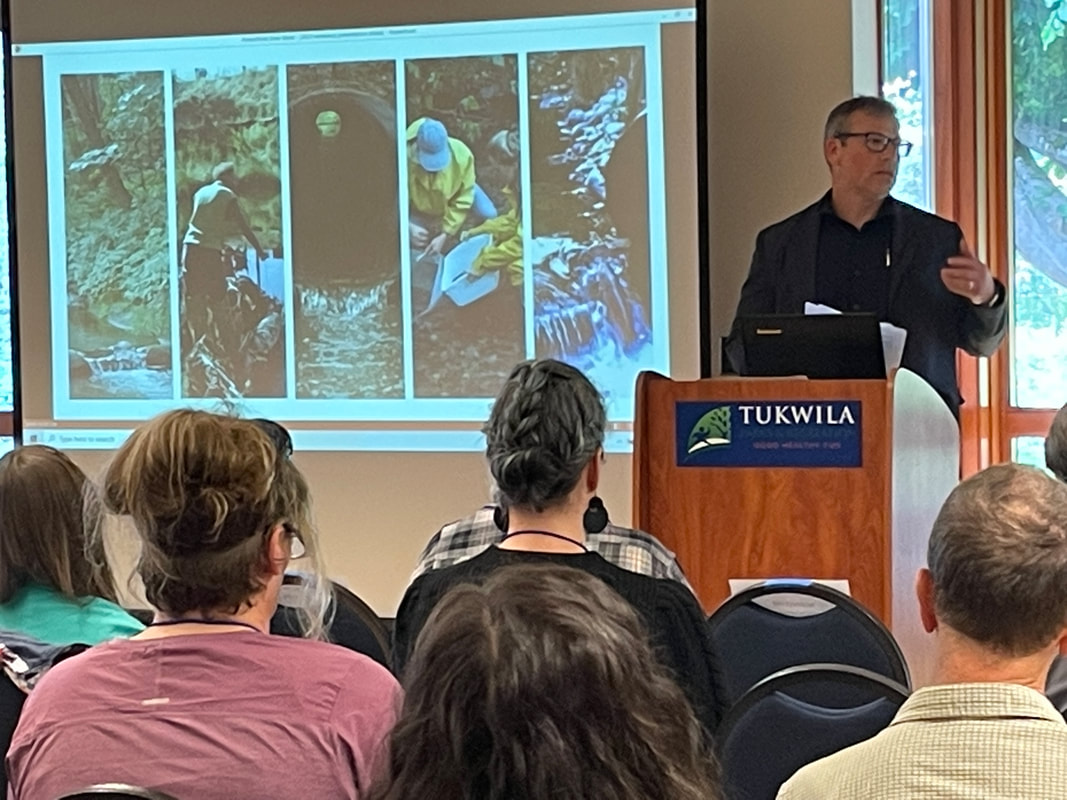Our Creeks, Streams and DitchesRevisit and become inspired again by the presentations and discussions which showcased the varied and exciting work being accomplished in our Green-Duwamish Watershed.
The presentation slides are for reference only and not to be published without the approval of the presenter/author. A River Being Reborn! |
|
Keynote Presentation
RESTORATIVE: Stewarding Our Shared Waters Ken Yocom, University of Washington Associate Professor and Chair of the Department of Landscape Architecture. |
| ||||||
6PPD & Water Updates
|
| ||||||||||||||||||||||||
2023 G-D Watershed Workshop Charrette Discussions
Discussion Facilitators:
Ashley Allan, Program Coordinator Urban Riparian Habitat Stewardship, King Conservation District
Caroline Borsenick, Director Environmental Education, Delridge Neighborhood Development Assn.
Alicia Kellogg, Duwamish Basin Steward, King County DNRP
Katherine Lynch, SPU Fish Biologist
Mike Perfetti, Habitat & Stormwater Manager, City of Tukwila
Greg Wingard, Director, Green River Coalition
Cool Ideas:
Discussion Highlights:
Water Quality & Habitat Discussion Highlights:
Community Engagement:
Potential Funding Resources:
Additional Resources:
Discussion Facilitators:
Ashley Allan, Program Coordinator Urban Riparian Habitat Stewardship, King Conservation District
Caroline Borsenick, Director Environmental Education, Delridge Neighborhood Development Assn.
Alicia Kellogg, Duwamish Basin Steward, King County DNRP
Katherine Lynch, SPU Fish Biologist
Mike Perfetti, Habitat & Stormwater Manager, City of Tukwila
Greg Wingard, Director, Green River Coalition
Cool Ideas:
- Mapping our empty parking lots that could be restored into natural habitat and then take the action to contact owners.
- Identify and name all tributaries draining into the Green-Duwamish River
Discussion Highlights:
Water Quality & Habitat Discussion Highlights:
- Green Duwamish Reveg Tracker shows projects by partners in various stages of completion and is managed by Alicia Kellogg, Duwamish Basin Steward and Kelley Govan, Lower Green Basin Steward. Any and all habitat restoration projects are encouraged to be included in this mapping resource. For further information, contact Alicia or Kelley.
- Advocate for public transit and ESJ
- Think about what we do to help – internalize the value of environmental and community stewardship
- Always leave a place better
- Build awareness, educate policy makers, tell decision makers “I care”
Community Engagement:
- It is all about relationships, and acknowledging that relationships take time!
- Use Fish Bowl Technique – in-depth technical conversation with public discussion groups: In this technique, attendees are separated into an inner and outer circle. In the inner circle, or fishbowl, inner circle attendees have a discussion; while attendees in the outer circle listen to the discussion and take notes. Afterwards, both sections discuss with each other. The technique enables a large group to all contribute to a single conversation.
- Messaging to non-engaged citizens via word of mouth: find the right person/organization that they trust, enlist their help to communicate with the community.
- Working with landowners in the community: to start the conversation/introduce technical terms, after work has been done in the community.
- Have successful examples to point to (ie a neighbor’s project) and talk about the bigger picture – this means being willing to provide education and have patience.
- Grassroots /local organizations need to be involved create PARTNERSHIPS!!!! Also include local schools.
- Give people something that demonstrates the value of their participation, what is their take away?
- Digital communications that are effective and actually work.
- Start with already plugged in community members to help reach community members.
- Working certain neighborhoods on Saturday, meeting where they are at. Adjust to the community, don't expect them to adjust to you.
- Offer childcare and food when holding a public meeting.
- Establish community engagement which builds trust, understands cultural, concerns and interests.
- Work with teachers, provide PEI – teacher professional development credits, if possible, for their continuing education requirements.
- To engage youth, understand how best to communicate with them – how they use apps, community outreach, word of mouth and other means within their community.
Potential Funding Resources:
- Urban Waters is working on creating some sort of funding directory. Weston Brinkley is a point of contact. weston@streetsoundsecology.com
- Rose Foundation is looking to fund work in the Duwamish Valley. They specialize in quick, low-barrier projects. Tim Bell is a point of contact. tbell@rosefdn.org
Additional Resources:
- Puget Sound Partnership has a Vital Signs website with great information
- EJ TCTACs – Environmental Justice Thriving Communities Technical Assistance Centers
- Two regional TCTACs in Washington: UW and Willamette
